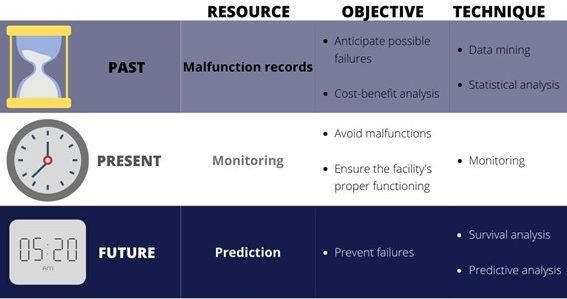What is predictive maintenance?
As we discussed in our articles “Smart Factories and Industrial Maintenance” and “Types of Industrial Maintenance”, predictive maintenance is the one that, following mathematical and statistical principles, analyses the factory’s big data (obtained through industrial automation systems) to identify anomalies that may negatively affect the industrial plant’s performance in order to solve them before they produce any major failure.
It is, therefore, a type of proactive maintenance that relies on the company’s capability to adopt new monitoring, automation and management technological tools. It also implies a greater investment in human resources, as its performance depends on the expertise of highly qualified professionals.
What is the objective of predictive maintenance?
The factories’ equipment and processes are becoming increasingly sophisticated, which requires the installation of highly reliable components to ensure the system’s accuracy. However, this means subjecting components to stress, as well as ensuring an optimum level of maintenance at all stages of the process to prevent the failure of one part/machine from affecting the health of the rest.
Globalisation has a similar effect, since, despite offering new business opportunities, it also involves a higher degree of competitiveness and it causes many industries to depend on imports. Consequently, the exporting countries’ context (logistics, electricity prices, tariffs, etc.) has a significant impact on their activity.
Thus, corrective maintenance is not an option in most cases, as many companies cannot afford to stop production (unless it is strictly necessary), or to spend part of their budget on fixing or replacing machines that, due to their complexity, are extremely expensive. This is because, on the international market, the product’s final price is of paramount importance and all these factors will have a negative impact on it, which may jeopardise the viability of the business.
On the other hand, even when preventive maintenance avoids some of the unforeseen charges that corrective maintenance incurs, it is not 100% effective. First of all, in a plant that execute high-precision processes using high-availability machines, it is not possible to schedule periodic overhauls that involve halting production. Also, it is not feasible to replace this kind of equipment before the end of its useful life due to its price. Finally, preventive maintenance does not monitor the state of the machinery at any time other than the moment of the inspection, so it cannot be applied to those companies that need real-time data to function properly.
For these reasons (among others), predictive maintenance is the only valid option for many organisations. The main advantage of this kind of maintenance is that it offers an exhaustive monitoring of the industrial plant. Thanks to the utilisation of sensors, cloud computing, AI, IoT (which enables the interconnection between systems), and, above all, to the adoption of predictive models, it is possible to identify patterns and dependencies in the available information. As a result, external factors that influence the production process can be monitored, and the resulting data can be used in combination with other information to facilitate managerial tasks. Moreover, knowing the state of the machinery and the variables that may affect its health enables the predictive analysis of its evolution.
Benefits of predictive maintenance
Therefore, the benefits of predictive maintenance, apart from others, are the following:
- It reduces maintenance expenditure. The facility’s inspection is carried out in a much more efficient and optimal way, as it is possible to choose when it will occur, taking into account factors such as the equipment’s estimated useful life, consumer demand, the time it will take to repair it or external factors.
- It increases productivity. Apart from reducing downtime and increasing overall performance, predictive models help to manage tasks, stock supplies, financial information and workflows.
- It helps to identify risks and new opportunities. When a predictive maintenance system is adopted, the analysis of the industrial plant’s information aids with the identification of inefficiencies, as well as with the prevention of risks derived from optimisation and improvement projects.
- It increases safety. A predictive approach is not only positive for the machines, but it is also very important to reinforce the workforce’s safety and well-being. In addition, it prevents human errors, which can lead to accidents at work and/or to production stoppages.
Industry 4.0 predictive maintenance plan
Nonetheless, these benefits are not obtained immediately, so, to reap its advantages, its implementation plan must be carefully designed so that the model is organically integrated into every industrial process. Consequently, we will now explain how to carry out an effective predictive maintenance.
How is an effective predictive maintenance carried out?
Firstly, a series of software, hardware and workforce control parameters should be established. For the software and the hardware, the organisation’s maintenance team can resort to the P-F curve, which indicates how each component’s deterioration evolves. This entails indicating when it was installed (I), the point at which a failure can begin to be detected (P) and when it will fail (F). Furthermore, before monitoring systems existed, it was not possible to measure the “vitals” of a machine in real time, but, thanks to current technological progress, not only is it possible, but they can also be objectively evaluated by comparing them with other variables such as the importance of the machine, the state of other devices involved in the process, customer demand, etc.
For industrial predictive maintenance, it is also essential to know which monitoring tools will be needed. These vary from one sector to another and from one company to another, as each of them will have its own particular needs. It should not be forgotten, in this regard, that the technology required for predictive maintenance is quite expensive and that, as a result, each executive board will have to decide which monitoring model is prioritised in each particular process.
Apart from these tools, maintenance teams can adopt a number of other control techniques to ensure that the most important variables are properly monitored. For example, vibration analyses, pressure monitoring, thermographies, partial discharge analyses, shock pulse monitoring, infrareds, ultrasounds and moisture/gas/noise detection are often useful. Thanks to them, parameters such as insulation, airtightness, corrosion, etc., can be monitored.
Finally, it is essential to have an industrial predictive maintenance implementation plan.
Industry 4.0 predictive maintenance implementation plan
The first step is the preparation of the predictive maintenance plan, which consists in determining which are the most important processes for the company’s activity. Then, the machines critical to these actions and the factors that are going to be measured are identified, and the techniques that are to be applied are chosen.
This phase also involves selecting a methodology, i.e. a systematic approach to the industrial plant’s maintenance that allow the predictive system to achieve the proposed objectives. This will influence the database’s format, which entails the establishment of:
- The overhauls’ frequency (provisionally).
- The importance of each parameter.
- The routes.
- Red flags (‘alarms’).
- The equipment’s settings.
The next step in an industrial plant’s predictive maintenance plan is its implementation. During this phase, it is necessary to “comply with what was agreed” in the previous step, which guarantees the objectivity of the process and ensures that the maintenance will be adapted to the particularities of the process for which it was designed. This is achieved through:
- Real-time measurements and their dump.
- The monitoring of anomalous behaviour and its diagnosis.
- The prevention or correction of these anomalies.
Finally, as in any plan, an assessment of the results is compulsory. This is the step in which the company must be self-critical, so it may resort to different techniques such as audits or the analysis of maintenance indicators.
An audit, in general terms, consists in devoting a professional or a team (internal or external) to the judgement of an enterprise’s operations (or part of them) in order to improve multiple aspects (such as efficiency, financial results or sustainability) through the establishment of short, medium and long-term objectives. In the case of maintenance audits, the quality of the chosen maintenance model and its results are periodically, objectively and systematically analysed.
Typically, the short-term goal of a maintenance audit is being able to formulate simple pieces of advice that help to optimise industrial operation. In contrast, long-term goals address those reforms that enhance the maintenance’s role as support of an entity’s viability. This can be measured by means of financial criteria or any other that the business’ executive may deem to be important, as audits have an unlimited scope.
The analysis of maintenance indicators, on the other hand, is a simple but effective assessment method. It implies comparing the plant’s current state with previous ones, as well as with the objectives proposed in the first phase of the plan. These objectives or indicators must meet the following criteria.
- They should not be too many, but only those necessary to guarantee the maintenance system’s improvement.
- They are easy to calculate and to understand.
- They are functional for maintenance issues, but they also help to achieve the company’s goals.
- They are subject to regular evaluation.
- They serve as the basis for strategic decision-making.
- They are adaptable.
- They are strategic: they help to identify both opportunities and risks.




